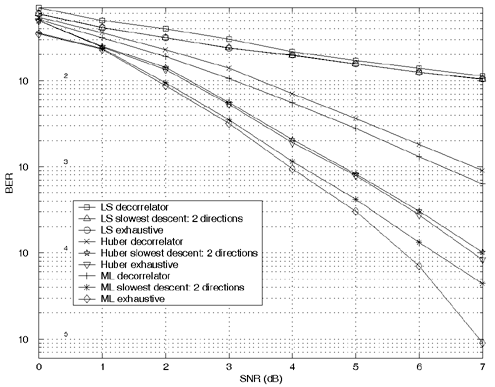4.6 Robust Multiuser Detection Based on Local Likelihood Search
4.6 Robust Multiuser Detection Based on Local Likelihood SearchRecall that in Section 3.4 we introduced a nonlinear multiuser detection method based on local likelihood search, which offers significant performance improvement over linear multiuser detection methods with comparable computational complexity. When combined with the subspace technique, this method also leads to a nonlinear group-blind multiuser detector. In this section we discuss the application of such a local likelihood search method in robust multiuser detection and group -blind robust multiuser detection. The materials in this section were developed in [455, 456]. 4.6.1 Exhaustive-Search and Decorrelative DetectionConsider the following complex-valued discrete-time synchronous CDMA signal model . At any time instant, the received signal is the superposition of K users' signals, plus the ambient noise, given by Equation 4.96 Equation 4.97 where, as before, where u is a real noise vector consisting of 2 N i.i.d. samples. Then (4.97) can be written as Equation 4.98 It is assumed that each element u j of u follows a two- term Gaussian mixture distribution: Equation 4.99 with 0 Equation 4.100 We have Cov ( u ) = ( s 2 /2) I 2N and Cov ( n ) = s 2 I N . Recall from the preceding sections that there are primarily two categories of multiuser detectors for estimating b from y in (4.98), all based on minimizing the sum of a certain function r ( ·) of the chip residuals Equation 4.101 where
Note that exhaustive-search detection is based on the discrete minimization of the cost function C ( b;y ), over 2 K candidate points, whereas decorrelative detection is based on the continuous minimization of the same cost function. As before, let y = r ' be the derivative of the penalty function r . In general, the optimization problem (4.103) can be solved iteratively according to the following steps [553]: Equation 4.105 Equation 4.106 Recall further from Section 4.2 the following three choices of the penalty function r ( ·) in (4.101), corresponding to different forms of detectors:
4.6.2 Local-Search Detection Clearly, the optimal performance is achieved by the exhaustive-search detector with the log-likelihood penalty function (i.e., the ML detector). As will be seen later, the performance of the exhaustive-search detector with the Huber penalty function is close to that of the ML detector, while this detector does not require knowledge of the exact noise pdf. However, the computational complexity of the exhaustive-search detector (4.102) is on the order of Equation 4.114 In the slowest-descent-search method, the candidate set W consists of the discrete parameters chosen such that they are in the neighborhood of Q ( Q For the three types of penalty functions, the Hessian matrix at the stationary points are given, respectively, by Equation 4.115 Equation 4.116 Equation 4.117 where, in (4.115), Equation 4.118 and in (4.117) the indicator function I ( y Denote b * Equation 4.119 Hence, { b q, m } m contains the K closest neighbours of b in {-1, +1} K along the direction of g q Note that { g q } Finally, we summarize the slowest-descent-search algorithm for robust multiuser detection in non-Gaussian noise. Given a penalty function r ( ·), this algorithm solves the discrete optimization problem (4.114) according to the following steps. Algorithm 4.4: [Robust multiuser detector based on slowest-descent-search ”synchronous CDMA]
Simulation ResultsFor simulations, we consider a synchronous CDMA system with a processing gain N = 15, number of users K = 6, and no phase offset and equal amplitudes of user signals (i.e., a k = 1, k = 1, . . . , K ). The signature sequence s 1 of user 1 is generated randomly and kept fixed throughout simulations. The signature sequences of other users are generated by circularly shifting the sequence of user 1. For each of the three penalty functions, Fig. 4.12 presents the BER performance of the decorrelative detector, slowest-descent-search detector with two search directions, and exhaustive-search detector. Searching further slowest-descent directions does not improve the performance in this case. We observe that for all three criteria, the performance of the slowest-descent-search detector is close to that of its respective exhaustive-search version. Moreover, the LS-based detectors have the worst performance. Note that the detector based on the Huber penalty function and the slowest-descent search offers significant performance gain over the robust decorrelator developed in Section 4.4 (Algorithm 4.1). For example, at the BER of 10 -3 , it is only less than 1 dB from the ML detector, whereas the robust decorrelator is about 3 dB from the ML detector. Figure 4.12. BER performance of various detectors in a DS-CDMA system with non-Gaussian ambient noise. N = 15, K = 8 |
EAN: 2147483647
Pages: 91







